
Module add-ons, worksheets, and activities for environmental science courses.
- Subject:
- Applied Science
- Environmental Science
- Material Type:
- Activity/Lab
- Homework/Assignment
- Reading
- Author:
- Kaitling Stack Whitney
- Date Added:
- 04/11/2023

Module add-ons, worksheets, and activities for environmental science courses.
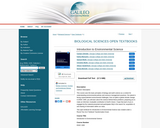
This course uses the basic principles of biology and earth science as a context for understanding environmental policies and resource management practices. Our planet is facing unprecedented environmental challenges, from oil spills to global climate change. In ENSC 1000, you will learn about the science behind these problems; preparing you to make an informed, invaluable contribution to Earth’s future. I hope that each of you is engaged by the material presented and participates fully in the search for, acquisition of, and sharing of information within our class.

a Canadian perspective
Long Description:
This textbook is intended to provide the core elements of a curriculum for teaching environmental science at the introductory level in Canadian colleges and universities. This book is suitable for students beginning a program in environmental science, environmental studies, or sustainability. It is also appropriate for arts students who require a science elective, and for science students who require a non-major elective. Not many introductory textbooks in environmental science are written in a way that provides a deep examination of issues that are particularly important in Canada, and the ways they are being dealt with by governments and society-at-large. Canada has unique national and regional perspectives that should be understood by Canadian students, and it is regrettable that many of them are studying from textbooks whose focus is not their own country. This book, however, was written from the ground-up to provide Canadian information and examples. This national context is integrated throughout the text, along with North American and global data that provide a broader perspective. Special Canadian Focus boxes illustrate important examples of environmental issues in our national context. At the same time, Global Focus boxes enhance the international context for learning about issues, while In Detail boxes examine particular topics in greater depth.
Word Count: 343995
(Note: This resource's metadata has been created automatically by reformatting and/or combining the information that the author initially provided as part of a bulk import process.)

Required for all Earth, Atmospheric, and Planetary Sciences majors in the Environmental Science track, this course is an introduction to current research in the field. Stresses integration of central scientific concepts in environmental policy making and the chemistry, biology, and geology environmental science tracks. Revisits selected core themes for students who have already acquired a basic understanding of environmental science concepts. The topic for this term is geoengineering.

a Canadian perspective
Short Description:
This textbook is intended to provide the core elements of a curriculum for teaching environmental science at the introductory level in Canadian colleges and universities.
Word Count: 343696
ISBN: 978-1-998755-79-0
(Note: This resource's metadata has been created automatically by reformatting and/or combining the information that the author initially provided as part of a bulk import process.)

Paul Anderson playlist of videos that can be used in an AP Environmental Science Class

This course offers a broad overview of physical, chemical, biological, geological, principles of environmental sciences, and serves as a core course for EEOS majors. Examples will focus on linked watershed and coastal marine systems. The student will be introduced to natural processes and interactions in the atmosphere, in the ocean, and on land. There is a focus on biogeochemical cycling of elements as well as changes of these natural cycles with time, especially with recent anthropogenic effects. Topics include plate tectonics, global climate change, ozone depletion, water pollution, oceanography, ecosystem health, and natural resources.
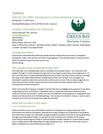
In this syllabus from Spring 2022, Dr. Jessica Warwick provides bibliographic citations for open education resources used in place of a traditional textbook. Topics include: Environmental Challenges; Ecosystem Cycling; Species Interactions; Populations; Evolution; Niches; Biomes; Biodiversity; Threats to Species; The Human Population; Food Issues; Agriculture; Sustainable Agriculture; Water; Soils; Non-Renewable Energy; Climate Change; Renewables; Economics; Politics

Gallery walk activity that relies on students' prior knowledge of environmental issues as an introductory activity in a general education, large-lecture format environmental science class.

The geologic record demonstrates that our environment has changed over a variety of time scales from seconds to billions of years. This course explores the many ways in which geologic processes control and modify the Earth’s environment and serves as an introduction to Environmental Earth Science Field Course (12.120), which addresses field applications of these principles in the American Southwest.
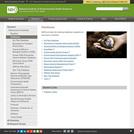
Today the NIEHS is expanding and accelerating its contributions to scientific knowledge of human health and the environment, and to the health and well-being of people everywhere. It provides the following databases & galleries as resources to scientists: The Alu Pairs Database, The Biomarkers of Oxidative Stress Study (BOSS), Chemical Effects in Biological Systems(CEBS), The Drug Matrix, The Environmental Genome Project, The Environmental Polymorphisms Registry, The Human DNA Polymerase Gamma Mutation, The Microarray Center cDNA Clone Search, Mouse Genome Resequencing Project, The Nanomaterial Registry, The Roadmap Epigenomics Project Data, The SNPinfo Web Server and the Spin Trap Database.
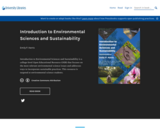
Short Description:
Introduction to Environmental Sciences and Sustainability is a college-level Open Educational Resource (OER) that focuses on the most relevant environmental science issues and addresses ways to incorporate sustainable practices. This resource is targeted at environmental science students.
Long Description:
Introduction to Environmental Sciences and Sustainability is a college-level Open Educational Resource (OER) that focuses on the most relevant environmental science issues and addresses ways to incorporate sustainable practices. The text is designed for an introductory-level college science course. Topics include the fundamentals of ecology, biodiversity, pollution, climate change, food production, human population growth, and incorporating sustainable approaches in our communities, economies, and environments. This resource is targeted at environmental science students.
Students can print a PDF copy of this text as a hard copy (at the student’s expense). Electronic copies of a PDF or the ebook are available through UWF’s Library Pressbook.
Contributors: Chasidy Hobbs, M.S. and Kwame Owusu-Daaku, Ph.D
Word Count: 118178
(Note: This resource's metadata has been created automatically by reformatting and/or combining the information that the author initially provided as part of a bulk import process.)
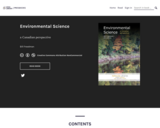
a Canadian perspective
Word Count: 330051
(Note: This resource's metadata has been created automatically by reformatting and/or combining the information that the author initially provided as part of a bulk import process.)

This site aims to increase student interest and preparation in the environmental health sciences so that they are aware of science career opportunities, and to increase public awareness about the impact of environmental agents on human health so that all citizens can lead healthy and productive lives.

This class examines the role of science in the US environmental policy-making process. It investigates the methods scientists use to learn about the natural world, the way scientific knowledge accumulates, the treatment of science by advocates and the media, and the role of science in legislative, administrative and judicial decision making. It also considers how other political systems use science in an effort to put the US approach in comparative perspective.

12.103 explores the role of scientific knowledge, discovery, method, and argument in environmental policymaking from both idealistic and realistic perspectives. The course will use case studies of science-intensive environmental controversies to study how science was used and abused in the policymaking process. Case studies include: global warming, biodiversity loss, and nuclear waste disposal siting. Subject includes intensive practice in the writing and presentation of “position statements” on environmental science issues.

Course combines the fields of ecology and conservation with planning for the efficient use and preservation of land, water, wildlife, and forests. Within this course may be topics covering environmental factors affecting water, water pollution, water and land use management, alternative energy resources, metals and minerals.
** References to Common Core Standards are included as the first slide in each lesson's PowerPoint**
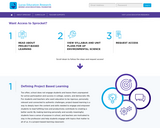
This course contains five projects, plus a course introduction and course closure, that are organized around the following question: “How can we rethink our use of the world’s resources?” Each project involves investigations of sustainability that help contextualize the content required by the new College Board course framework.

This folder currently includes Environmental Science: People to Know Lab, Environmental Science: Ethnobotany Lab, and Example: Pacific Northwest Ethnobotany: Native Plants & Their Uses Slides for ESR 171 Fall 2020.
ESR 171 Environmental Science: Biological Perspectives
Covers environmental topics that are primarily biological in nature, including ecosystem functions, biodiversity, human population issues, agricultural practices, and environmental ethics. Laboratory exercises illustrate these topics and may include fieldwork.
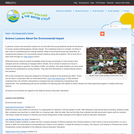
Science and education experts caution that climate-change topics can overwhelm and frighten young children. Science lessons chosen for this article focus on general environmental issues, such as the effects of litter, air pollution, and water pollution. The lessons also include actions and solutions to environmental issues. The free, online magazine Beyond Weather and the Water Cycle focuses on integrating age-appropriate science learning with literacy experiences.